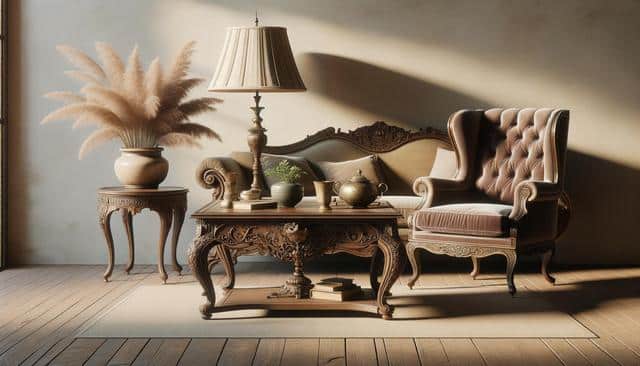Discover the Timeless Appeal of Vintage Furniture: A Complete Guide
Explore the timeless beauty of vintage furniture and how it can elevate your home décor. This guide offers valuable tips on selecting, restoring, and caring for vintage pieces, helping you create a stylish and unique interior. Discover the charm of classic furniture today.

What Makes Vintage Furniture So Special?
Vintage furniture stands out for its craftsmanship, character, and history. Unlike mass-produced modern pieces, vintage items often boast unique design details and high-quality materials that have stood the test of time. Each scratch or patina tells a story, adding authenticity and personality to your living space. For many homeowners and interior enthusiasts, incorporating vintage furniture is not only about aesthetics but also about sustainability. By choosing pre-loved items, you reduce waste and support a more eco-conscious lifestyle.
These pieces also allow for a level of customization and creativity that new furniture may not offer. Whether it’s a mid-century modern armchair or a rustic farmhouse table, vintage finds can easily become conversation starters in any room. Their timeless appeal ensures they remain relevant, even as design trends evolve. Investing in vintage furniture is not just about decorating a home—it’s about curating a personal collection that reflects your taste and values.
How to Find Quality Vintage Pieces
When shopping for vintage furniture, knowing where and how to look is key. Start with trusted sources like estate sales, antique shops, consignment stores, and online marketplaces. These venues often offer a wide range of styles and eras, giving you plenty of options to explore. Visiting local flea markets and garage sales can also uncover hidden gems at affordable prices.
Here are some tips for identifying quality vintage furniture:
- Inspect the construction: Solid wood, dovetail joints, and hand-carved details are good indicators of quality.
- Check for labels or maker’s marks: These can help you trace the piece’s origin and assess its value.
- Evaluate the condition: Look for signs of wear, but avoid items with structural damage unless you’re prepared to invest in repairs.
- Ask questions: Learn about the item’s history, previous owners, and any restoration work that has been done.
Doing your research before making a purchase can save you time, money, and potential disappointment. Don’t rush the process—finding the right vintage piece is often a rewarding journey in itself.
Restoring and Refinishing Vintage Furniture
Restoration can breathe new life into old furniture, but it’s important to approach this process with care. Some pieces only require light cleaning and minor touch-ups, while others might need more extensive work. Begin by assessing what needs to be done and determine whether you can handle the restoration yourself or need professional help.
Common restoration tasks include:
- Cleaning and polishing wood surfaces
- Reupholstering fabric chairs and sofas
- Repairing loose joints or broken parts
- Stripping and refinishing worn finishes
When refinishing, aim to preserve the original character of the piece whenever possible. Over-restoring can strip away the patina and historical value. Use gentle, non-abrasive cleaners and avoid harsh chemicals that could damage the materials. If you’re unsure about a technique, consult a restoration specialist for guidance. With the right approach, you can enhance the beauty and functionality of vintage furniture while preserving its unique charm.
Incorporating Vintage Furniture into Modern Spaces
One of the great things about vintage furniture is its versatility. Whether your home leans toward minimalism, industrial, or eclectic design, vintage pieces can add warmth and contrast. The key is to mix old and new elements in a balanced way to avoid a cluttered or outdated look.
Here are some ideas for integrating vintage furniture into modern interiors:
- Pair a vintage coffee table with a contemporary sofa
- Use a retro sideboard as a media console
- Incorporate antique chairs into a modern dining room
- Balance bold vintage patterns with neutral tones
Lighting also plays a crucial role in highlighting vintage features. Consider using spotlights or statement lamps to draw attention to special items. Don’t be afraid to experiment—part of the appeal of vintage furniture is its ability to stand out and make a space feel curated and personal. By thoughtfully placing vintage pieces in your home, you create a dynamic visual narrative that blends history with modern living.
Maintaining and Caring for Your Vintage Finds
Proper care is essential to preserve the beauty and longevity of vintage furniture. Unlike newer items, vintage pieces may require specific maintenance routines tailored to their materials and age. Regular dusting with a soft cloth helps prevent buildup, while occasional polishing can enhance the finish of wood surfaces.
Here are some general care tips to keep in mind:
- Keep furniture away from direct sunlight to prevent fading
- Use coasters and placemats to protect surfaces from spills and heat
- Apply furniture wax or oil periodically to nourish wood
- Vacuum upholstered items using a soft brush attachment
- Address minor repairs promptly to prevent further damage
It’s also a good idea to rotate items occasionally to ensure even wear, especially for pieces like rugs or cushions. If your furniture has metal components, check for rust and clean them with appropriate products. Storing vintage items in a stable environment with consistent temperature and humidity can further help prevent deterioration. Ultimately, regular care not only maintains the appearance of your furniture but also protects your investment for years to come.